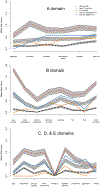Diagnosis of Autism Spectrum Disorder After Age 5 in Children Evaluated Longitudinally Since Infancy
- PMID: 30392626
- PMCID: PMC6235445
- DOI: 10.1016/j.jaac.2018.06.022
Diagnosis of Autism Spectrum Disorder After Age 5 in Children Evaluated Longitudinally Since Infancy
Abstract
Objective: The diagnosis of autism spectrum disorder (ASD) has been found to be remarkably stable but few studies have followed children not initially diagnosed with ASD beyond 3 years of age to examine late or delayed diagnoses. The present study used a prospective familial-risk design to identify children who had undergone multiple comprehensive assessments in preschool and were determined to be negative for ASD only to meet criteria for ASD when tested in middle childhood.
Method: Data were pooled across 3 research teams studying later-born siblings of children with ASD. Fourteen children met inclusion criteria for the late-diagnosed group and were compared with a large sample of high- and low-risk siblings from the same sites who had ASD or typical development (TD) outcomes at 3 years of age.
Results: As a group, the late-diagnosed children scored between the TD and ASD groups on most measures administered at 3 years and differed significantly from the ASD group on most measures. However, there was significant heterogeneity among the late-diagnosed cases. Seven showed very little evidence of ASD in preschool, whereas 7 demonstrated subtle, subthreshold symptomatology.
Conclusion: Some children with ASD might present with a subtle phenotype early in life or show a prolonged time course of symptom development. This emphasizes the need for screening and surveillance schedules that extend past 36 months and continued evaluation of any child who presents with atypical early development and/or high-risk status. The findings also shed light on reasons why the mean age of ASD diagnosis remains older than 4 years.
Keywords: autism spectrum disorder; diagnosis; diagnostic stability.
Copyright © 2018 American Academy of Child and Adolescent Psychiatry. Published by Elsevier Inc. All rights reserved.
Figures
Comment in
-
For Better or for Worse? Later Diagnoses of Autism Spectrum Disorder in Some Younger Siblings of Already Diagnosed Children.J Am Acad Child Adolesc Psychiatry. 2018 Nov;57(11):822-823. doi: 10.1016/j.jaac.2018.08.008. J Am Acad Child Adolesc Psychiatry. 2018. PMID: 30392621 Free PMC article.
References
-
- Woolfenden S, Sarkozy V, Ridley G, et al. A systematic review of the diagnostic stability of autism spectrum disorder. Res in ASD. 2012;6:345–354.
-
- Michelotti J, Charman T, Slonims V, et al. Follow-up of children with language delay and features of autism from preschool years to middle childhood. Dev Med Ch Neurol. 2002;44:812–819. - PubMed
-
- Elmose M, Trillingsgaard A, Jorgensen M, et al. Follow-up at mid-school age (9–13 years) of children assessed for autism spectrum disorder before the age of four. Nord J Psychiat. 2014;68:362–368. - PubMed
Publication types
MeSH terms
Grants and funding
LinkOut - more resources
Full Text Sources
Medical
Research Materials
Miscellaneous


